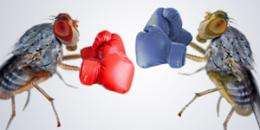Not quite 'roid rage: Complicated gene networks involved in fly aggression

(PhysOrg.com) -- Fruit fly aggression is correlated with smaller brain parts, involves complex interactions between networks of important genes, and often cannot be controlled with mood-altering drugs like lithium.
Those are the results of a painstaking study conducted by researchers at North Carolina State University and colleagues in Belgium who are trying to discover what happens in the genes and brains of hyper-aggressive flies and how that differs from what takes place in more passive fly cousins.
Dr. Trudy Mackay, William Neal Reynolds Distinguished University Professor of Genetics and a co-lead author of a paper published this week in Proceedings of the National Academy of Sciences, says that the findings in the fruit fly could one day lead to helping humans – think of Alzheimer’s patients who suddenly become more aggressive – by providing a framework of how complex gene interactions affect behavior. Fruit flies are model organisms for studying genes and traits like aggression.
In the study, the researchers showed that making changes, or mutations, to a handful of genes made some passive flies aggressive and made some aggressive flies really aggressive. They also showed the effects of mating flies with different mutations to see which mutant combinations had larger effects on aggression.
The researchers also showed that certain portions of the fly brain – the so-called mushroom bodies, which affect locomotion, experience and memory – were smaller in the hyper-aggressive flies.
The study also showed that calming did not necessarily come through chemistry, as doses of lithium soothed some but not all of the aggressive flies. These mixed results were also evident when flies were given two other types of calming drugs.
“This study shows that these brain networks are not simple, and that you can’t look at just one gene at a time,” says study co-author Dr. Robert Anholt, William Neal Reynolds Professor of Biology at NC State.
The researchers measured aggression by watching for fly actions that include, in order from less aggressive to more aggressive: chasing other flies; puffing up their wings in a “wing threat” position; kicking other flies; and, for the roughest flies, standing on their back legs and boxing other flies with front legs.
More information: Complex Genetic Architecture of Drosophila Aggressive Behavior. Published: The week of Sept. 26, 2011, in the online version of Proceedings of the National Academy of Sciences.
Provided by North Carolina State University















